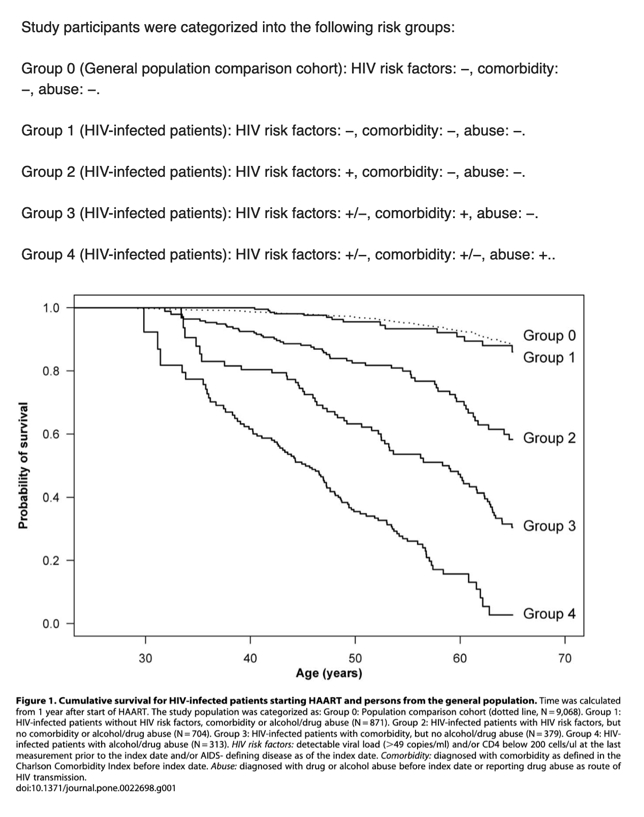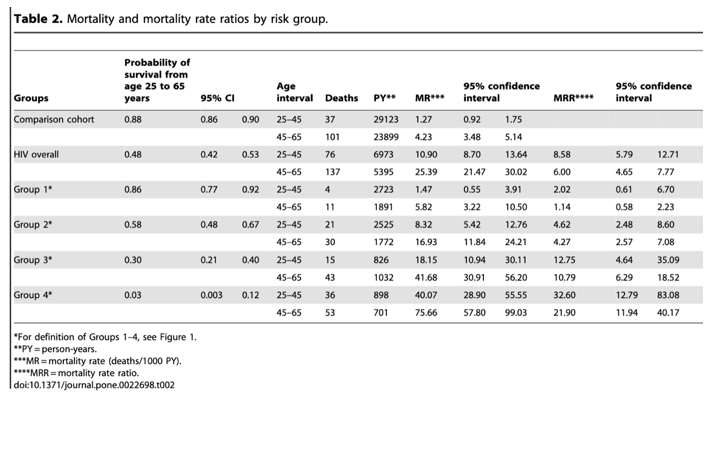| |
PLWH Survival Declines with Comorbidities Danish Cohort
|
| |
| |
Download the PDF here
probability of survival declined to 0.58 in Group 2 (patients with HIV risk factors), to 0.30 in Group 3 (HIV-infected patients with comorbidity)
Recently, comorbidity has been identified as the major risk factor for death among HIV-infected patients not yet on HAART [19]. We supplement this finding by demonstrating that comorbidity, as well as HIV risk factors and alcohol/drug abuse, are also major risk factors for death in HIV-infected patients on HAART.

Published: July 25, 2011
Niels Obel1, Lars Haukali Omland1*, Gitte Kronborg2, Carsten S. Larsen3, Court Pedersen4, Gitte Pedersen5, Henrik Toft Sørensen6,7, Jan Gerstoft1
1 Department of Infectious Diseases, Copenhagen University Hospital, Rigshospitalet, Copenhagen, Denmark, 2 Department of Infectious Diseases, Copenhagen University Hospital, Hvidovre Hospital, Hvidovre, Denmark, 3 Department of Infectious Diseases, Aarhus University Hospital, Aarhus Sygehus, Aarhus N, Denmark, 4 Department of Infectious Diseases, Odense University Hospital, Odense C, Denmark, 5 Department of Infectious Diseases, Aarhus University Hospital, Aalborg Sygehus, Aalborg, Denmark, 6 Department of Clinical Epidemiology, Aarhus University Hospital, Aarhus Sygehus, Aarhus N, Denmark, 7 Department of Epidemiology, Boston University School of Public Health, Boston, Massachusetts, United States of America

Abstract
Background
We determined the impact of three factors on mortality in HIV-infected patients who had been on highly active antiretroviral therapy (HAART) for at least one year: (1) insufficient response to (HAART) and presence of AIDS-defining diseases, (2) comorbidity, and (3) drug and alcohol abuse and compared the mortality to that of the general population.
Methodology/Principal Findings
In a Danish nationwide, population-based cohort study, we used population based registries to identify (1) all Danish HIV-infected patients who started HAART in the period 1 January 1998-1 July 2009, and (2) a comparison cohort of individuals matched on date of birth and gender (N = 2,267 and 9,068, respectively). Study inclusion began 1 year after start of HAART. Patients were categorised hierarchically in four groups according to the three risk factors, which were identified before study inclusion. The main outcome measure was probability of survival from age 25 to 65 years.
The probability of survival from age 25 to age 65 was substantially lower in HIV patients [0.48 (95% confidence interval (CI) 0.42-0.55)] compared to the comparison cohort [0.88 (0.86 to 0.90)].
However, in HIV patients with no risk factors (N = 871) the probability of survival was equivalent to that of the general population [0.86 (95% CI 0.77-0.92)].
In contrast, the probability of survival was 0.58 in patients with HIV risk factors (N = 704), 0.30 in patients with comorbidities (N = 479), and 0.03 in patients with drug or alcohol abuse (N = 313).
The HIV population suffered from substantially increased mortality [MRR = 8.58 (95% confidence interval 5.79 to 12.71) among patients aged 25-45 and MRR = 6.00 (4.65 to 7.77)] among those aged 45-65). However, in Group 1 (HIV-infected patients without HIV risk factors, comorbidity, or alcohol/drug abuse) mortality was almost equal to that of the general population comparison cohort for the age group 45-65 [MRR = 1.14 (0.58 to 2.23)], but doubled for the age group 25-45 [MRR = 2.02 (0.61 to 6.70)] (Table 2).
The relative risk of death increased by risk group (Table 2), ranging from a fourfold increased risk of death in HIV patients aged 45-65 years with HIV risk factors, but no comorbidity or alcohol/drug abuse, to a more then 20-fold increased risk of death in HIV patients registered with alcohol or drug abuse. The probability of survival at 65 years of age was 0.48 among HIV-infected patients and 0.88 in the general population comparison cohort. However, for HIV patients with no risk factors, the probability of survival at age 65 was 0.86 (Figure 1). The probability of survival declined to 0.58 in Group 2 (patients with HIV risk factors), to 0.30 in Group 3 (HIV-infected patients with comorbidity), and to 0.03 in Group 4 (those with alcohol or drug abuse).
Conclusions
The increased risk of death in HIV-infected individuals is mainly attributable to risk factors that can be identified prior to or in the initial period of antiretroviral treatment. Mortality in patients without risk factors on a successful HAART is almost identical to that of the non-HIV-infected population.
Risk factors
Risk factors were defined as follows:
HIV risk factors.
Detectable viral load (>49 copies/ml) and/or CD4 below 200 cells/ul at the last measurement pr
ior to the index date and/or AIDS- defining disease as of the index date.
Comorbidity.
Diagnosed with comorbidity (excluding AIDS-defining diseases) as defined in the Charlson comorbidity index (CCI) [12]-[14] before the index date. Hepatitis C, if registered in the Danish HIV Cohort Study, also was included as comorbidity.
Alcohol and drug abuse.
Drug abuse reported as the route of HIV transmission or hospital contacts before the index date with the following diagnoses: ICD-8: 29100-29199, 57109, 57110, 30300-30389, 30391-30399, 30409-30499; and ICD-10: K700-K709, F102-109, G312, F110-199, or T400.

|
|
| |
| |
|
|
|